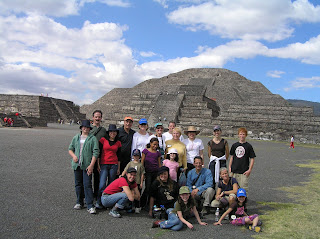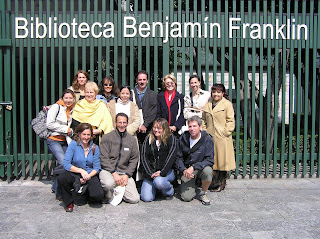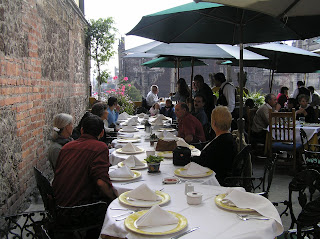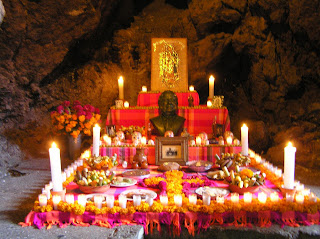In face-to-face relationships, Mexicans are among the most considerate, courteous people in the world, with a finely tuned deference to the other person in their immediate presence. People trying to sleep, however, are out of sight, out of mind. There's no point in trying to go to bed before 11, because the tamales vendors will soon make their rounds on bicycles outfitted with stands carrying big pots of steaming tamales. By this time of night they must be tired of chanting their sales pitch, because they have a recording blaring in the sing-song cadence of hawkers, "Tamales oaxaqueños, tamales calientitos..." And it goes on and on. I joked with some students that I didn't think I would be able to get to sleep without this chant when we return to the US. They said, "Don't worry. We can download it as a ring tone for you."

Organ grinders perform on busy streets; it's picturesque for people passing by and we even sometimes put coins in the hat of our favorite one, a man with a very pleasant smile. But last weekend, an organ grinder stationed himself on our corner to take advantage of a crowd lined up for a performance at the Metropolitan. He might as well have been right inside my ear! We wondered how much we would have to tip him to get him to stop, but instead just left the apartment for awhile.
We often stop for lunch in Chapultepec, in an area full of food stalls, most selling the same food, all with one or two hawkers rattling off their menus. Last weekend we went to a national park, el Desierto de los Leones, to ride bikes. Here's a photo of the ex-convento in the park.
There they were, the same menu-rattling hawkers, same cadence. I wonder if it really brings in more business?
The worst noise pollution comes from drivers. Mexicans drive with one hand on the wheel and the other on the claxon (horn). Should the first car at a stop light not move forward the instant before the light turns green, all the others will lay on their horns. And every Mexican seems to know that the best way to get a traffic jam cleared is to toot horns. Maybe that signals the policemen standing on the busy corners to give loud blasts on their whistles.

Organ grinders perform on busy streets; it's picturesque for people passing by and we even sometimes put coins in the hat of our favorite one, a man with a very pleasant smile. But last weekend, an organ grinder stationed himself on our corner to take advantage of a crowd lined up for a performance at the Metropolitan. He might as well have been right inside my ear! We wondered how much we would have to tip him to get him to stop, but instead just left the apartment for awhile.
We often stop for lunch in Chapultepec, in an area full of food stalls, most selling the same food, all with one or two hawkers rattling off their menus. Last weekend we went to a national park, el Desierto de los Leones, to ride bikes. Here's a photo of the ex-convento in the park.

There they were, the same menu-rattling hawkers, same cadence. I wonder if it really brings in more business?
The worst noise pollution comes from drivers. Mexicans drive with one hand on the wheel and the other on the claxon (horn). Should the first car at a stop light not move forward the instant before the light turns green, all the others will lay on their horns. And every Mexican seems to know that the best way to get a traffic jam cleared is to toot horns. Maybe that signals the policemen standing on the busy corners to give loud blasts on their whistles.
I don't have to set my alarm here. The man selling ice comes early and shouts, "Hielo" in a way that makes this short word last for minutes - well, at least several seconds. And the cacophony starts all over again.









































